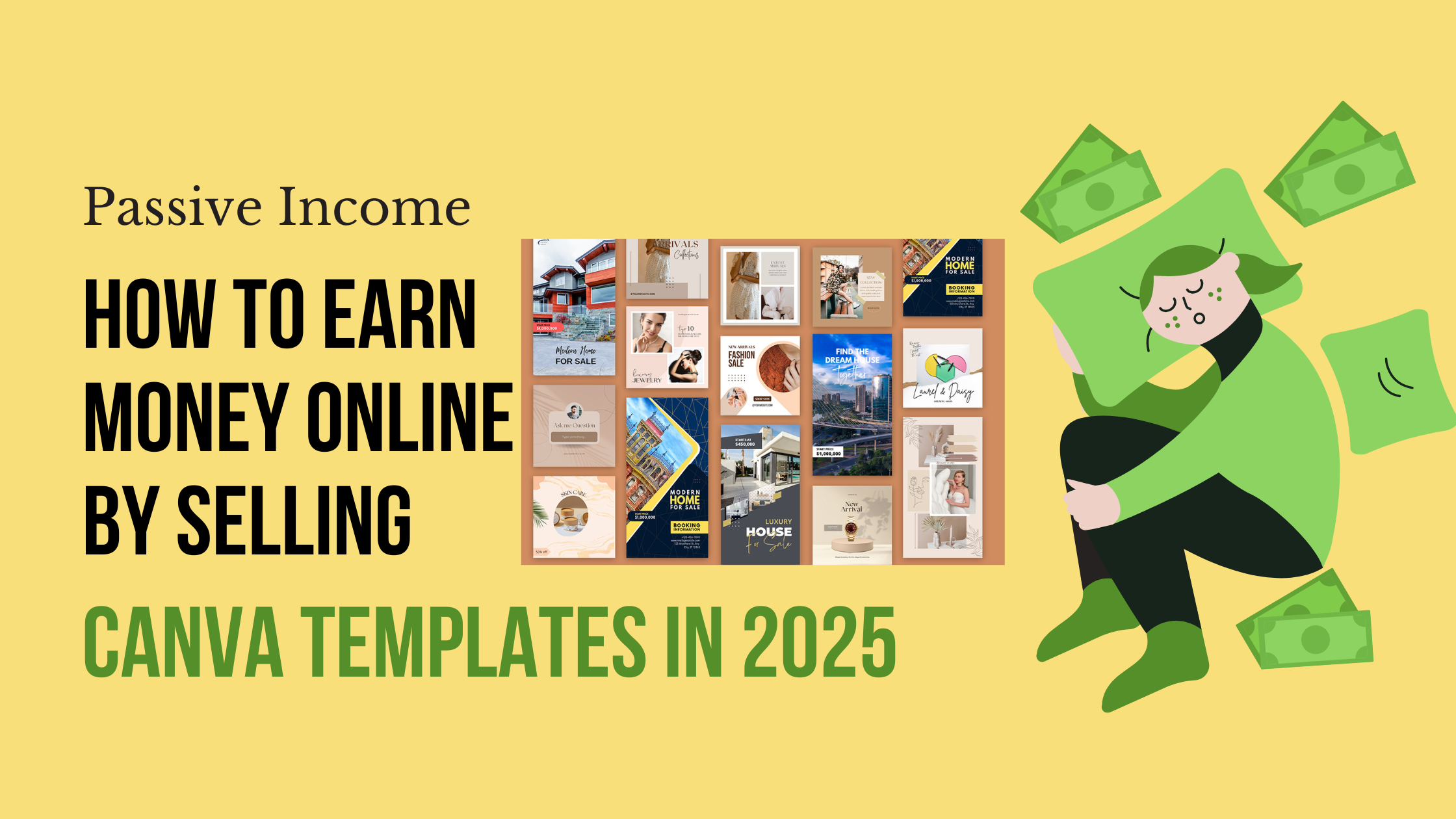Step-by-Step Guide to Selling Canva Templates
Step 1: Research Your Niche
The first and most crucial step in selling Canva templates is to identify your niche. Without this, it’s easy to get lost in the sea of generic templates, and you might find it difficult to stand out. By researching and honing in on a specific area, you give yourself the best chance for success.
Start by researching the types of templates that are currently popular and in demand. There are plenty of platforms like Etsy, Creative Market, and Pinterest where you can look for inspiration and gather ideas. These platforms not only allow you to see what others are selling, but they also offer insight into what’s trending and where there’s room to fill gaps. For example, social media templates might be in high demand, but resume designs might be more niche and offer a unique opportunity.
While browsing, pay attention to trends and specific audiences. Are there any specific types of templates that seem to be doing well among small business owners or students? This can give you direction in choosing a target market. For instance, if you find that a lot of students are searching for resume designs, you can focus your efforts on creating a variety of stylish, ATS-friendly resume templates.
Consider what your audience might need or what they might be looking for. The more specific you get with your niche, the easier it will be to create designs that resonate with your audience. Plus, it allows you to tailor your marketing efforts, which can make it easier to attract customers.
In my experience, the best first step is to see where there’s demand. Look for gaps in the market or areas that haven’t been over-saturated with offerings. By carving out your space in a specific niche, you can focus on becoming an expert in that area—whether it’s marketing designs for coaches or event invitations for weddings.
Once you’ve done your research and identified your niche, you’ll be ready to move on to the next step: creating designs that meet the needs of your target audience.
Step 2: Create High-Quality Templates
Once you’ve identified your niche, it’s time to start designing your templates with intention and quality in mind. Whether you’re using Canva’s free or Pro versions, you can create high-quality templates that not only look beautiful but are also functional and easy for buyers to use. You can use either version to create your templates, but the Pro version offers extra features like premium fonts, stock photos, and advanced design tools that can give your templates a polished edge.
Templates should be visually appealing, but more importantly, they must be easy for customers to edit and customize. Focus on creating professional, clean layouts with balanced elements that don’t overwhelm the design. Often, the most effective templates are simple, purposeful, and adaptable across various industries.
Experiment with Canva’s built-in tools—fonts, shapes, grids, and alignment features—to make your designs not just attractive but also user-friendly. Templates that are too complex or confusing often lead to customer frustration. Usability is key if you want good reviews and repeat buyers.
To make your templates truly unique, consider adding subtle touches like a color guide or font pairing suggestions within the file. This adds value and helps customers feel more confident when editing. Templates that perform best are often the ones that offer clear structure while still allowing personal branding adjustments.
When your template is ready, save it as a shareable link. This allows customers to access and edit the template directly in Canva—no downloads, no complicated instructions. Just one click and they’re ready to go.
Keep these tips in mind throughout your creation process, and you’ll soon have a collection of high-performing templates that not only serve your niche but help establish your brand as a go-to resource for high-quality, easy-to-use design assets.
Step 3: Price Your Templates
Setting the right price is a balancing act—one that can significantly affect your sales and brand perception. When I first began selling, I had no idea what to charge. But over time, I learned that smart pricing starts with researching competitors. Visit marketplaces like Etsy or Creative Market and see how they price similar templates within your niche. Take note of what’s included: is it a single template, a bundle, or a premium layout with extras?
For a single template, prices typically range from $5 to $25, depending on the quality, complexity, and audience. Bundles or complex designs can fetch higher prices—sometimes $50 or more—especially if they offer lots of value and customization options.
Start by offering slightly lower prices initially to attract customers and build trust. This approach helped me gain traction when I had no reviews. Then, as your reputation grows, you can increase them gradually without losing buyers. Think of your first few months as a test period to learn what your audience is willing to pay.
It’s crucial to understand that pricing isn’t set in stone. Consider running promotions, experimenting with different tiers, or bundling your bestsellers together. These tactics can help you understand buyer behavior and increase your overall earnings without overwhelming your workload.
The key is to find that sweet spot—where your pricing reflects the quality of your work while remaining competitive. Done right, your pricing strategy can do just as much for your brand as the design itself.
The digital marketplace thrives on simplicity and value—two things Canva templates deliver effortlessly. But beyond demand, your success hinges on setting the right price. Early in my journey, I underestimated how researching competitors could shape my strategy. Start by exploring shops that price similar templates, and see how they structure their offerings. This isn’t about copying—it’s about understanding the market pulse.
When launching, offering lower prices initially helps attract customers and build momentum. My first single template sold for .Prices typically range from 5 to $25 for standalone designs, but don’t shy away from testing higher tiers for specialized content.
As your reputation grows, gradually increase them. For instance, after gaining 50 five-star reviews, I raised my base rate by 20%. Clients who valued quality stayed, and newcomers perceived the hike as a mark of credibility.
Bundles can amplify your earnings effortlessly. Pairing social media kits or eBook covers often justifies a more premium tag. One of my bestsellers—a “Brand Launch Bundle”—combined logos, banners, and pitch decks, selling for triple the cost of individual items.
Complex designs, like animated Instagram stories or multi-page workbooks, fetch higher prices. I once doubled my rate for a project management template suite simply by adding interactive elements. Consider your audience’s needs: For a solopreneur, affordability matters, while agencies might prioritize customization. Flexibility is crucial.
Price Your Templates isn’t a one-time task. Revisit your strategy as your portfolio expands. Balance competitiveness with confidence in your work’s worth—then watch your side hustle evolve into a steady income stream.
Step 4: Choose a Selling Platform
You need a platform that lets you showcase and sell your templates effectively. With so many popular options, focus on what aligns with your goals: visibility, fees, or creative freedom. Early on, I prioritized marketplaces with active buyers to kickstart sales, but later shifted to platforms offering full control over branding and customer experience.
Here are some of the most common choices:
Etsy boasts 94 million buyers, making it ideal for beginners. However, its $0.20 per listing fee and 6.5% transaction fee add up quickly. Selling on Etsy worked for me initially, but I outgrew it as I sought more ownership.
Gumroad is an easy-to-use platform for digital products, charging a flat 10% fee per sale. Its simplicity helps creators focus on design, not logistics. I’ve used it for niche templates, appreciating its lack of upfront charges.
Creative Market, a design-focused marketplace, connects you with millions of customers, but it takes at least 50% commission. While this cut stings, the exposure can justify it for high-volume sellers.
For full control, build Your Website using Squarespace or similar tools. Own site sales mean keeping 100% of profits and tailoring the customer experience. I migrated here after two years—using tools like embedded widgets to enable purchases directly on my portfolio.
Weigh the pros and cons:
Each platform charges differently. Etsy has processing fees, Gumroad takes a slice per sale, and Creative Market demands half your revenue. Meanwhile, Your Website requires upfront work but offers creators long-term flexibility.
Choose one (or multiple) based on your stage. Early on, leverage built-in audiences; later, diversify. I once sold the same template bundle on Etsy and my site, testing where it performed best.
Step 5: Market Your Templates
Marketing is the engine driving sales for your Canva templates. Without it, even the best designs gather dust. Early on, I learned that promote isn’t a one-time task—it’s a rhythm. Here’s how to turn visibility into revenue.
Here are some tips to amplify your reach:
Social Media platforms like Instagram and Pinterest are goldmines for showcase designs. Posting time-lapse creation videos or before/after templates helped me attract customers organically. Use hashtags like CanvaTemplates or DesignWithMe to tap into niche communities.
SEO matters just as much as visuals. Write detailed, keyword-rich product descriptions (e.g., “Modern Wedding Instagram Template Pack”) to help your templates rank in search results. When I optimized titles and tags, my Etsy shop traffic doubled in three months.
Freebies are your secret weapon. Offer free templates in exchange for email sign-ups—a tactic that helped me build trust and grow my audience to 2,000 subscribers. These leads later converted into paying customers for new products or discounts.
Email Marketing keeps your tribe engaged. Send email newsletters highlighting updates, tutorials, or limited-time offers. I Use a biweekly format: one educational tip, one product spotlight. It’s key to keep informed your base without overwhelming them.
Consistency is non-negotiable. Whether it’s daily Pinterest pins or weekly emails, steady effort gain momentum. I blocked 30 minutes each morning purely for promotion—a habit that boosted my visibility by 40% in six months.
The more you promote, the more you’ll see patterns in what resonates. Test carousel posts vs. reels, or paid ads vs. collaborations. Treat every campaign as data, not guesswork.
Step 6: Scale Your Business
Scaling isn’t just about making sales—it’s about strategically growing your reach and impact. When I first hit $1k/month, I realized Add new templates regularly was the key to momentum. But don’t just repeat what works—explore different niches. After noticing a surge in wellness content, I pivoted from generic social media packs to yoga studio branding kits, tripling my audience.
Bundling products is a stealthy way to increase earnings. A client once asked for a “Content Creator Bundle”; I combined Instagram carousels, media kits, and invoice templates, priced at 30% more than individual items. It became my top seller overnight.
Gather customer feedback religiously. Early on, I sent post-purchase surveys asking, “What’s missing?” Those insights helped me refine designs and stay ahead of trends—like adding TikTok templates before they blew up.
Once you start gaining traction, look for ways to automate. I outsourced customer service using chatbots, freeing up hours to focus on design. Consider tools like Trello or Notion to your workflow efficient.
This phase takes time and dedication. For two years, I treated my side hustle as a part-time job before it could turn into a full-time income. Consistency matters: regularly audit your bestsellers, tweak pricing, and experiment with new formats.
Conclusion
Selling Canva templates merges the creative with the practical, offering a profitable avenue to generate passive income. By researching your niche, designing high-quality templates, and promoting them effectively, you’ll build a thriving digital business that can evolve from a side hustle into a full-time venture.
Whether you’re looking for supplemental income or aiming to replace your day job, the digital marketplace holds endless opportunities. My own journey began with a single Instagram template—now, I earn recurring revenue while sleeping, thanks to evergreen designs that keep selling.
Read Also: canva pro link


